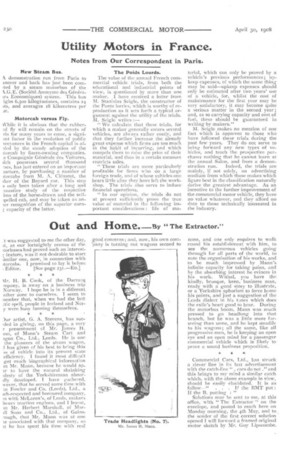Utility Motors in France.
Page 10

If you've noticed an error in this article please click here to report it so we can fix it.
Notes from Our Correspondent in Paris.
New Steam Sus.
• A. demonstration run from Paris to mover and back has just been cornted by a steam motorbus of the ‘.G. E. (Societe Anonyme des Generatrs Economiques) system. This bus ighs 6,500-kilogrammes, contains 24 its, and averages IS kilometres per r.
Motoreab versus Fly.
• ‘,Iftile it is obvious that the rubberal fly will remain on the streets of ris for many years to come, a signiant factor in the evolution of public weyances in the French capita] is af
• ded by the steady adoption of the aorcab by fiacre-owning companies. e Compagnie Generale des Voitures, iich possesses several thousand 7ses, has just entered on an important )arture, by purchasing a number of Aorcabs from M. A. Clement, the deer of the Bayard .car. Tins step. s only been taken after a long and latistive study of the respective ims of the horse-drawn and the selfTelled cab, and may be taken as anier recognition of the superior earn; capacity of the latter. The Poids Lourds.
The value of the annual French commercial vehicle trials, from both the educational and industrial points of view, is questioned by more than one maker. I have received a letter from M. Stanislas Seigle, the constructor of the Pantz lorries, which is worthy of reproduction as it sets forth a typical argument against the utility of the trials. M. Seigle writes :— " We calculate that these trials, for which a maker generally enters several vehicles, are always rather costly, and that they further increase the already great expense which firms are too much in the habit of incurring, and which compels them to raise the price of their material, and thus in a certain measure restricts sales.
" These trials are more particularly profitable for firms who do a large foreign trade, and of whose vehicles one hears little after they have left the workshop. The trials also serve to induce financial operations.
" In our opinion, the trials do not at present sufficiently prove the true value of material in the following important considerations : life of ma
feria], which can only be proved by a vehicle's previous performances ; upkeep expenses, of which the same thing may be said—upkeep expenses should only be estimated after two years' use of a vehicle, for, whilst the cost of maintenance for the first year may be very satisfactory, it may become quite a serious matter in the second year; and, as to carrying capacity and cost of fuel, these should be guaranteed in writing by makers."
M. Seigle makes no mention of one fact which is apparent to those whO have followed these trials during the past few years. They do • not serve to brine.forward any new types of vehicles, and teach the prospective purchaser nothing that he cannot learn at the annual Salon, and from a demon
stration run. Indeed, the trials are mainly, if not solely, an advertising medium from which those makes which figure best in the classification naturally derive the greatest advantage. As an incentive to the further improvement of the commercial motor vehicle, they have no value whatever, and they afford no data to those technically interested in the industry.


































